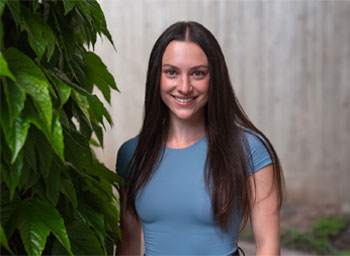Olivia Hawco was eight years old when she heard a scream from the bathroom — it was her mom, who’d just felt something pop in her brain.
Hours later, Hawco learned her mom had a 50/50 chance of surviving. She’d suffered a massive stroke, the kind that kills most people before they can even get to the hospital.
Doctors couldn’t operate or intervene, so they transferred her to another hospital for more tests. Miraculously, they found the bleeding in her brain had spontaneously healed itself.
“I remember the neurologist saying, ‘Your mom won the lottery,’” Hawco says. “The only thing I wanted when I was a little girl was for my mom to be okay. And I want that for other people too.”
Recovery wasn’t so fortuitous; Hawco’s mother was hospitalized for a week and had to relearn how to walk. They never found out why she healed so suddenly, nor why her only lasting symptom was some minor difficulty with her short-term memory.

But Hawco did find out she had a lifelong passion — to understand and treat brain diseases, and ultimately prevent them from happening at all. Now, 14 years later, she’s already made some serious headway.
Hawco began volunteering at the Markham Stouffville Hospital at 16, where they’d initially taken her mom. She started out in the gift shop as a cashier and worked her way through the wings, assisting with CT scans, cardiology and oncology, and eventually helping in the same ICU where her mother almost died. It was hard to be back, Hawco says, but that only made her more certain she was on the right path.
She later enrolled at U of T Scarborough to pursue a specialist in human biology, and in her third year took a course taught by Professor Kathlyn Gan from the department of biological sciences. Hawco grew fascinated with Gan’s neuroscience research, then landed a position in Gan’s lab, where she has remained ever since.
“Although she joined my lab with no prior research experience, Olivia quickly grasped a wide variety of sophisticated experimental techniques that can elude experienced trainees,” Gan says. “Notably, she designed and executed her own undergraduate research project from scratch, systematically troubleshooting and optimizing her own experiments.”
Hawco is investigating neurons, the cells responsible for transmitting information around the brain. More specifically, she’s studying how neurons communicate by linking with one another through connections called synapses. Synapses degrade over time, leading to many of the aspects of aging people dread most, like memory loss, cognitive decline and fatal diseases such as dementia.
For her undergraduate thesis, Hawco narrowed in on a protein called SLIT1, which guides neurons to their proper place during early brain development. Hawco suspected SLIT1 plays a larger role and could also be impacting the way neurons connect to one another. So far, she’s discovered it does.
She’s essentially working backwards — examining how the brain first forms to hopefully create a drug or treatment that can help a damaged brain reform.
“If you're able to form synaptic connections and prevent neuronal death sooner after a stroke, you wouldn't have the same detrimental side effects,” she says. “Maybe that can prevent some of the cognitive decline we see.”

Her work earned her the prestigious NSERC Undergraduate Student Research Award last year, and as she prepares to build on her data and embark on more experiments during her master’s in the fall, she’ll be supported by the NSERC Canada Graduate Scholarship — Master’s Program. She also won the U of T Excellence Award to support her research this summer.
Along with her family, Hawco credits the support she received from her mentors in the department of biological sciences, including Gan and professors Aarthi Ashok and Emily Bell. When she’s not in the lab, she was involved in several campus clubs, including the Biological Sciences Students Association and MedLife. She also played soccer for most of her life and became a referee at 16, a role that’s had a surprisingly pervasive influence.
“Being a referee was hard as a young girl. You have parents, grown men, yelling at you and it can be daunting. I’ve heard my fair share of sexist comments. But I wouldn't trade it for anything, because it's made me realize the importance of confidence, having a thick skin, being a leader and advocating for yourself.”
Hawco is now en route to becoming a clinician scientist, a role that hybridizes researcher and doctor.
“I don't think somebody should be tied down to one career when something exists to let you do both,” she says. “It’s the best of both worlds.”
